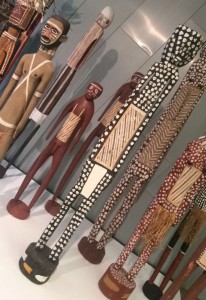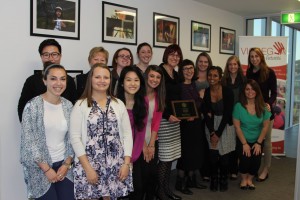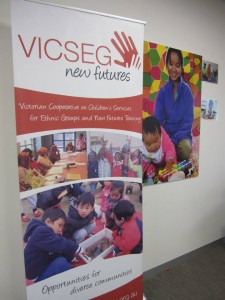Did anyone else know that Australia had such a diverse culture?
Forty-six percent of Australians have at least one parent who was not born in Australia. Wow. That is nearly half the entire population!
In my first blog post, Parisa and I spoke a little to the diverse foods, such as Asian and Italian, that we were seeing but I wanted to complicate that a bit. Whenever I asked about “Australian food” I was typically bet with several phrases such as “Uhhhh,” “Well,” and “Uhmmm”. But when you think about it for yourself, I can’t really think of hardly any traditional American foods either. As it seems, Australia is just as much of a melting pot as the United States is, and perhaps even more so. Arabic, Bosnian, Cambodian, Chinese, Dutch, French, Greek, Italian, Polish, Russian, Spanish, Vietnamese are all spoken in Australia, just to name a few. Of course, the first people’s to arrive to Australia were the Aboriginals. Then in the 17th and 18th centuries many Europeans came to explore, such as the Dutch and the British. During the 1800s several Chinese and other Asians came to New South Wales to work in the gold fields during the gold rush. Consider too, the simple proximity of Asia to the land down under. After World War II was another time of massive immigration from European countries to Australia.
Being an egocentric American, I always thought that the United States was always where refugees and immigrants came when they needed to escape or leave their home country. If I wanted to leave my home country, though, I think Australia would be an excellent choice. I was amazed at VICSEG by the emphasis that they placed on linking up refugees with people of their own culture via playgroups. The idea of having community workers who have recently undergone the immigration process themselves show new refugees the ropes of day to day living really struck me as well.
Did anyone else know that Australia had a rich Aboriginal history?
The Aboriginals have had their own culture for the past 40,000 to 60,000 years, marking themselves as one of the oldest living populations on Earth. In this time, the organized their own government, produced their own language, created rules around mating and marriage and found a way to make a highly functioning society. They created their own methods of healing such as herbs, massages, secret chant and steam baths. I appreciated learning that if the Aboriginals were living on a piece of land too long and they noticed it was taking a toll on the environment they would move to a new location. Furthermore, Aboriginals traditionally only took what they needed from the ecosystem: if there were two eggs in the nest and they only needed one at the time they would leave it. As an American, that blows my mind, only taking what you need- we’re so greedy. Though much of their history is not written, the Aboriginals have a thriving oral history that includes over 500 language groups.
Many are doing all that they can to save and preserve the Aboriginal culture. Today, several Aboriginal families still follow traditional gender-based roles, such as only the men being allowed to play the didgeridoo. When it comes to the elders, men play the biggest role in settling disputes meanwhile women handle mating totems and marriage. And every time we walked into an agency and they acknowledged the original owners of the land I got chills. Unfortunately, however, this has not always been done. It breaks my heart to know that the government did not issue a formal apology to the Stolen Generation until February 13th, 2008, and still there is much work to be done.
Did anyone else know how innovative Australians could be?
The Lighthouse Foundation, Young and Well and Reach Out all struck me as highly innovative and original.

Coat of Arms, picture taken at The Melbourne Museum
Young and Well and Reach Out are doing a fantastic job of researching and creating new ways that technology can affect and improve the mental health and wellbeing of young people. I think the United States is currently underestimating how much technology can influence teenagers and that we really need to follow Australia’s footprints in this department. I also really loved how The Lighthouse Foundation is set up, placing four youth in one home with two full time carers and a community base around that home to support them. The foundation plans to expand from just forty beds to one thousand beds over the next year and it is my hope that there framework can become the basis for other agencies all over the country.
Also, I just wanted to mention the Australian Coat of Arms, or crest, because it has been something I have been so absolutely hung up on and something that I have shared with nearly all of my friends and family. The Coat of Arms is the official symbol of the Commonwealth of Australia and features a red kangaroo and an emu. Okay, so what? Many people say that these two animals where chosen not only because they are indigenous to Australia, but because they are two animals that cannot move backwards. The kangaroo and the emu only move forward, signifying the progress Australia is striving to achieve.
Did anyone else know how similar the US and Australia are?
When most people think of Australia I would venture to guess that they either picture beautiful beaches or a dry,  dangerous dessert. I had this idea that Australia would be so absolutely different from the United States. Sure, Australians drive and walk on the opposite side of the road and every living creature there could kill you, but on a day-to-day basis it really was not that different. Just like in Columbus, the people of Australia wake up every morning and go to work, use their selfie sticks, love their football and cannot escape road construction for the life of them.
dangerous dessert. I had this idea that Australia would be so absolutely different from the United States. Sure, Australians drive and walk on the opposite side of the road and every living creature there could kill you, but on a day-to-day basis it really was not that different. Just like in Columbus, the people of Australia wake up every morning and go to work, use their selfie sticks, love their football and cannot escape road construction for the life of them.
Helena at VACCA spoke of the systematic racism that Aboriginals still are facing today. According to her prison rates for Aboriginals are still disproportionately high compared to the general population. Aboriginals face stereotypes of being violent, angry and always on welfare. Still, the Aboriginal history is not really taught in the school system. When she was saying all of this I could not help but to think of how Americans still portray and treat our American Indians.
Did anyone else know how absolutely friendly and helpful Australians are?
One thing that always makes an impact on me is how people treat me. Just walking the streets, on the train or in a shop nearly everyone we came across was kind. People went out of their way to be nice to us, even given our awkward group of fourteen loud women. On our first day in Melbourne we were walking to the Preston Market and a older gentleman stopped us and asked us if we would like to pet and play with his dogs. How simple (and of course we wanted to pet them, we’re young women!) but that struck me so and I can say that I have never had that happen here in Ohio. Everyone is so self-involved in the states. We tend not to think of others unless it benefits us. In the trains and trams we often had people ask us if we needed help getting somewhere, and often time we did. When we asked a question on the street we were always met with a positive attitude, rather than annoyance or rudeness.

Playing some beach volleyball with Outback Billy!
Our agencies were very warm and welcoming as well. I feel like I keep saying this phrase but I was amazed that almost if not all the agencies had morning tea and coffee with biscuits for us as soon as we got there. A few agencies even offered us lunch on their own dime. In down time, faculty usually engaged with us one-on-one asking about our personal lives. I value all the time that Trish took in helping Dr. Cash organize this incredible experience with us. I never expected for her to bring her whole family out just to have dinner and meet all of us. And honestly, Outback Billy and Holistic Hiker, Katie, went above and beyond for us. Looking back, it really touched my heart that Outback Billy drew up a mock volleyball court on the beach and started a little game of volleyball with us.
Did anyone know else how much I would change from just one-month abroad?
I grew up in a little village in Appalachia. I thought Columbus and its diversity had changed me, and it has, but it was nothing compared Australia. I have lived a sheltered life. I had never been west of the Mississippi, let alone out of the country. Now that I have been, I cannot wait to leave again! People keep asking me if I want to go back to Australia, and sure, I would love too but I cannot help but asking, what else have I been missing out on? Where else can I go next? A fire has been lit inside of me.
Now, I am only twenty-one and only going into my fourth year of undergrad. I do not feel that I can say that I one hundred percent want to work in the social work field for the rest of my life. If anything, Australia and this program have left me questioning my plans for the future—but that is okay, it is actually a good thing. Even though I am a social work major thi s program has given me a newfound respect for the field. It is one thing to learn about social work in the classroom but it is truly a completely different thing to watch it happen in front of you in real-world situations. The added culture value was a pure bonus!
s program has given me a newfound respect for the field. It is one thing to learn about social work in the classroom but it is truly a completely different thing to watch it happen in front of you in real-world situations. The added culture value was a pure bonus!

 At VICSEG, they recognize the struggles and the hardships that refugees and immigrants face when coming to a new country. They may struggle with not only the language, but also cultural norms and even simple things such as how to purchase items at the grocery store. In class, many of us have learned of the hardships in theory, but to solidify our understanding VICSEG played us a video following the refugee stories of two families on their way to Australia. One family coming from a dirty refugee camp in Burma was use to not having electricity and struggling for food. The other family was coming from Africa to reunite with their eleven-year-old daughter, Lily, who was separated from them as an infant during war. None of us, including some of the workers, guessed how this video would make us feel inside. Until this point, too, we had not realized how diverse our own group of fourteen was as well- we have two students with Italian heritage, a student with parents from India, one student from Vietnam, a student with a Lebanese father and Parisa’s father is from Iran. The video hit Parisa close to home because it reminded her of her Papa and him moving to the United States alone in the 1970s during the Iranian Revolution. He moved to America without a firm understanding of the language and also experienced several bouts racism. Though we all became very emotional, there was a great silver lining: the families on the screen and our families had all shown enormous amounts of resilience.
At VICSEG, they recognize the struggles and the hardships that refugees and immigrants face when coming to a new country. They may struggle with not only the language, but also cultural norms and even simple things such as how to purchase items at the grocery store. In class, many of us have learned of the hardships in theory, but to solidify our understanding VICSEG played us a video following the refugee stories of two families on their way to Australia. One family coming from a dirty refugee camp in Burma was use to not having electricity and struggling for food. The other family was coming from Africa to reunite with their eleven-year-old daughter, Lily, who was separated from them as an infant during war. None of us, including some of the workers, guessed how this video would make us feel inside. Until this point, too, we had not realized how diverse our own group of fourteen was as well- we have two students with Italian heritage, a student with parents from India, one student from Vietnam, a student with a Lebanese father and Parisa’s father is from Iran. The video hit Parisa close to home because it reminded her of her Papa and him moving to the United States alone in the 1970s during the Iranian Revolution. He moved to America without a firm understanding of the language and also experienced several bouts racism. Though we all became very emotional, there was a great silver lining: the families on the screen and our families had all shown enormous amounts of resilience.

